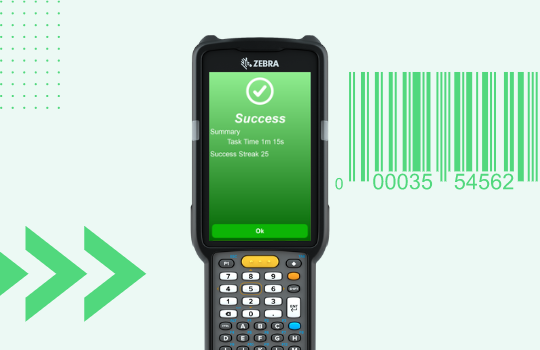Guide to Choosing the Best Inventory Management Software
- Digital Transformation
- Inventory/Warehouse
Key Takeaways:
- Inventory management software with built-in automation has been found to increase accuracy and profits.
- There is no one-size-fits-all solution for inventory management software—it’s about the best product for your business objectives and industry.
- While manual inventory management is prone to cost-draining errors, mobile inventory solutions have been found to help companies achieve 99.9% accuracy and more.
Understanding the importance of inventory management is crucial for any organization. After all, if products are not properly traced, accounted for, and utilized, there are far-reaching effects across the product life cycle, from procurement to delivery.
Proper inventory management involves a holistic view of all products with the goal of ensuring a smooth supply chain operation and minimizing costs. Through the use of inventory management software, organizations can streamline their approach to inventory for optimal results.
Inventory management software automates inventory processes, improving accuracy, efficiency, and profits. And with the average on-hand inventory quantities up 8.3% over the previous five years, it’s no wonder the inventory management software market is expected to grow to over $2.56 billion by 2029.
But how do you choose what inventory management software is right for you?
This article will provide a guide for organizations looking to select the right inventory management software.
Understanding Your Business Needs
The road to choosing the right inventory management technology begins with understanding your current business needs and inventory processes.
Analyze Existing Processes
Review your warehouse procedures to identify areas of inefficiency:
- Inventory turnover
- Stock control
- Demand forecasting
- Reorder points
- Safety stock
- Customer demand vs current inventory levels
- Material handling processes
Then look for areas where your inventory management process can improve. By having a proper understanding of your inventory, you can not only make your warehouse more efficient, but also improve profit margins and reduce costs.
Align Process with Business Goals
Once you have an understanding of your overall operation and how it’s functioning, the next step is to align your processes with your business goals and objectives.
After all, there is no shortage of challenges facing supply chain professionals in today’s marketplace. In developing short-term and long-term goals for your organization, you can better align inventory strategies to achieve those objectives.
Take Myers Tire Supply for instance, their long-term goal was to improve customer service and boost efficiency. To do this, they started by implementing lean supply chain models and just-in-time methodologies for inventory management. From there, they implemented mobile barcoding to increase accuracy and efficiency and gain full inventory visibility within their distribution centers.

How Myers Tire Supply improved operations with mobile inventory management software
READ THE FULL STORY »Determine Operational Requirements
Finally, ensure you are aware of the specific requirements for your business and industry type. Tracking, monitoring, and distributing inventory are universal needs for organizations, but how you do it and the quantities of product you have will fluctuate based on your industry or business size.
Food suppliers, for example, hold a significant portion of operational revenue in their purchased but unused inventories, necessitating improved inventory control procedures. E-commerce, on the other hand, will often focus on maintaining the right amount of inventory in a store or warehouse to ship to customers around the clock.
For enterprise companies using an ERP platform, determining technical requirements is also crucial. The best inventory management software vendor options will offer standard integrations for your ERP, if not validated or certified solutions. Many will also hold some level of partnership with the ERP company itself.
Ultimately, these factors hold significant implications for the type of inventory management software you choose. Understanding your needs will help in selecting software and ensuring successful implementation.

Steps to a Successful Implementation: What to Expect for Barcode Software
DOWNLOAD NOW »Key Features to Look for in Inventory Management Software
Research has shown that despite technological advancements, many companies continue to utilize spreadsheets or manual methods for inventory management. Supply Chain Dive recently found that over 67% of supply chain managers use Excel to keep track of inventory.
That’s a problem.
Spreadsheets are only slightly better than paper processes and woefully inadequate, especially for inventory at scale.
Couple this with the reality that the highest accuracy achievable with paper processes is only about 60%. For those who are tracking inventory manually or in spreadsheets, there’s a substantial risk of lost materials, mispicks, wrong orders, wasted time and money, and lack of operational efficiency.
That’s why it’s important to choose the right inventory management software that can help automate your processes, optimize your workflows, and streamline warehousing and production. Selecting software that can address your specific types of inventory, from raw materials to finished goods and safety stock, is essential to achieving accurate and efficient operations.
Important Inventory Management Features
Key features to look for include:
- Real-time inventory updates that interface with business-critical systems like ERPs, RFID, IoT, Industry 4.0 devices, and more—providing a single source of truth.
- Barcode scanning, which allows workers to capture perfect data, driving accuracy and visibility.
- Enterprise mobility to enable maximum flexibility and productivity.
- Purchase order management, which reduces risk of supply chain disruption by knowing what stock is on hand.
- Advanced inventory tracking capabilities like batch traceability, bulk moves, intelligent put-away, and offline data collection.
- Optimal replenishment automation to prevent delays and unnecessary expenses from back orders, double-ordering, and more.
- Collaboration with other software systems, like manufacturing execution systems (MES) and warehouse management platforms (WMS) to handle more sophisticated supply chain operations.
On-Premises or Cloud-Based Deployment
Companies must also decide between on-premises versus cloud-based solutions. Software as a service (SaaS) functionality has become the de facto choice for most solutions, reducing maintenance burden on IT departments. However, some organizations may require on-premises deployments that cloud-only providers can’t do.
Some solutions vendors can offer hybrid software or deployments that can easily migrate from on-premises to cloud, when the need arises.
Despite its benefits, almost half of RFgen Digital Inventory Report respondents have no plans to migrate to the cloud. Although today’s cloud solutions are more secure than ever before and continue to become even more resilient, many still avoid this transition due to security concerns related to cloud-based technology.
When choosing new inventory management software, it’s important to evaluate the risks, benefits, and practical concerns about deployment before making a purchase. This way, you can find the right solution that will work best for your business needs.

A Comprehensive Guide to Mobile Inventory Management Systems
READ NOW »Evaluating and Comparing Inventory Management Software Providers
There is no one-size-fits-all inventory management solution. Numerous factors go into which software will work best for you. That’s why it’s essential to do the background work on your needs and goals prior to software selection.
Look to Providers with Proven History
Once you’re ready to research available software providers, start by looking at the industry leaders. Review their approach to inventory management and their methodology, as well as ways they’ve helped clients similar to you implement inventory best practices.
For specific industries, consider niche providers that specialize in industry-specific solutions. Consider the elements you’ll need in order to be successful—and competitive—in your industry. Food and beverage companies may need to automate traceability as part of their software acquisition, for example. Meanwhile, industrial manufacturers may want shop floor data collection.
For instance, Carlisle Interconnect Technologies sought to improve accuracy and efficiency to mitigate risk as an aerospace-defense contractor. They needed a very specific type of vendor with competencies in their industry that could handle stringent security requirements. As a result, the outcome was tremendously successful.
Watch the CarlisleIT story below:
Do Your Homework
Before you make a decision, read reviews, testimonials, and case studies related to your selected vendors. If there are common issues about poor customer experiences that happen across multiple clients, you may want to rethink your options.
Regardless of technology, a software provider that offers a collaborative buying and implementation experience is typically the best option to ensure a successful project.
One way to understand if a vendor can meet your needs is by requesting a demo or meeting with the sales team for a discovery call. Enterprise software doesn’t always offer a free trial, so use these opportunities to gather detailed information, such as capabilities and inventory management software features.
If exploring a live demo of the software, request a personalized experience so you can see real-world applications of the system.
Consider Cost—and ROI
There is also the matter of cost. New inventory software can be a big investment for any organization and it’s normal to get some degree of sticker shock. However, factoring in the return on investment (ROI) can help you make the decision to purchase and implement.
More complex, expensive software solutions take longer and more resources to implement, so take longer to achieve payback. Meanwhile, you may be able to get the capabilities you need with a more cost-effective solution that deploys quickly and achieves ROI in a matter of months.
Beyond ROI, make sure you compare pricing plans, paying special attention to the types of payment options (one-time purchase versus SaaS subscription). Factor in additional costs that may arise, including support mitigation, upgrades, and customization of products or applications. Some vendors offer annual or pre-paid support plans to help you budget for the software.

How to Calculate ROI for Warehouse Automation Software
GET THE GUIDE »Making the Final Decision
After a thorough review of your current situation, your overarching goals, and the potential vendor options, all that’s left is to make the final decision. Remember, no inventory management software solution will be a perfect fit. Instead, select the software that best aligns with your business needs and objectives.
The Cost of Waiting
Research has shown that accuracy has a significant impact on a company’s bottom line. Manual processes can cost upwards of $10,000 a day in ineffective tracking. Mispicks alone can exacerbate overhead headaches by $200,000 per year. A single error incurs $50-$150 in total costs.
Implementing mobile inventory software can fix multiple supply chain issues through automation. In addition to reducing material handling costs by 10% or more, advanced data collection functionality boosts accuracy to 99.9%, saving companies hundreds of thousands of dollars per year.
The reality is, doing nothing can cost you big in the long run. Waiting to implement a new inventory solution could be negatively impacting your profitability and potential for growth.

Why Doing Nothing Can Cost You Big in the Warehouse
READ NOW »Preparing for Implementation
When it comes time to prepare for implementation ensure you have the right people to discuss data migration and integration setup. This may involve aligning internal and external resources.
In addition, don’t forget about your people. Employee acceptance of new technology is a necessity to its success. Look for ways to provide multiple training options, incentivize use of items like mobile barcoding, and talk in terms of benefits long term.
Find a solution that’s intuitive enough that staff can easily adopt the new technology and will actually commit to using it on a daily basis.
Having a proactive training program in place can help prevent worker resistance throughout the onboarding and implementation process.

Effective Tips for Finding and Training Top Warehouse Workers
LEARN MORE »How to Choose the Right Inventory Management Software
Inventory management is a critical function of business success. With the right tool in place, your company can optimize processes and maximize efficiencies, resulting in significant cost savings.
But that’s only if you’ve done the work to choose the best option. Begin with an understanding of your company and where it’s headed. Look at inefficiencies and opportunities. Then do your research on products that match your company size, industry, and customer base. Choose an inventory management solution based on research and evaluation.
Ultimately, whatever inventory solution you choose to improve your operations, being well-informed is the best way to equip your team with the confidence to select the right software for your organization.




